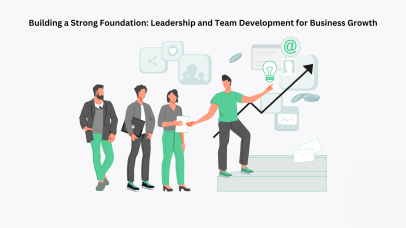Building a Strong Foundation: Leadership and Team Development for Business Growth
Introduction
Effective leadership and a well-developed team are the cornerstones of sustained growth in today's competitive business landscape. Leaders who inspire, motivate, and guide their teams foster innovation, collaboration, and productivity. In this blog, we’ll explore how to cultivate strong leadership and team dynamics to propel your business forward.
1. The Importance of Leadership in Business Growth
- Vision and Direction: A good leader provides a clear vision and sets actionable goals that align with the company’s mission.
- Inspiring and Motivating: Leaders who engage and inspire their teams create an environment where employees feel valued and driven to achieve more.
- Adaptability: In a fast-changing world, leaders who embrace change and encourage innovation set the tone for success.
Example: Elon Musk’s leadership style inspires innovation, allowing Tesla to lead in sustainable energy solutions.
2. Characteristics of an Effective Leader
- Emotional Intelligence: Understanding and managing emotions fosters trust and collaboration.
- Decision-Making Skills: Strong leaders make informed, timely decisions.
- Accountability: Great leaders own their mistakes and encourage others to do the same.
- Empathy: Leaders who genuinely care about their team’s well-being build loyalty and morale.
3. Strategies for Leadership Development
- Continuous Learning: Attend workshops, read industry literature, and seek mentorship.
- Feedback Mechanisms: Regularly seek and act on feedback from your team.
- Delegate Effectively: Trust your team with responsibilities to empower them and free up your time for strategic tasks.
- Practice Inclusive Leadership: Foster diversity and inclusivity in decision-making.
4. Building a High-Performance Team
- Hiring for Culture Fit and Skills: Look for candidates who align with your company values while bringing the necessary skills.
- Clear Communication: Transparent and consistent communication avoids misunderstandings and builds trust.
- Encourage Collaboration: Use tools and practices that promote teamwork, such as brainstorming sessions or project management software.
- Provide Training Opportunities: Invest in professional development programs to help your team grow.
5. Fostering a Positive Work Culture
- Recognize Achievements: Celebrate wins—big or small—to boost morale.
- Encourage Work-Life Balance: Support flexible working arrangements to avoid burnout.
- Create a Feedback Loop: Regular check-ins and open communication foster continuous improvement.
- Team Bonding Activities: Strengthen relationships through team-building exercises, retreats, or casual events.
6. Managing Conflicts Effectively
- Address Issues Early: Don’t let small disagreements escalate into bigger problems.
- Listen Actively: Understand each perspective before making decisions.
- Mediation Skills: Act as a neutral party to guide discussions toward a resolution.
- Focus on Solutions: Aim for win-win outcomes to maintain harmony.
7. Measuring Leadership and Team Development Success
- Employee Retention Rates: A well-led and satisfied team is likelier to stay.
- Productivity Metrics: Track performance and efficiency improvements.
- Feedback Surveys: Gather insights from employees on leadership and team dynamics.
- Business Performance: Monitor revenue growth, customer satisfaction, and other KPIs.
Conclusion
Leadership and team development go hand in hand. By cultivating strong leadership and fostering a collaborative team environment, businesses can achieve remarkable growth. Remember, success is not just about reaching milestones but about creating a sustainable ecosystem where both leaders and teams thrive.





